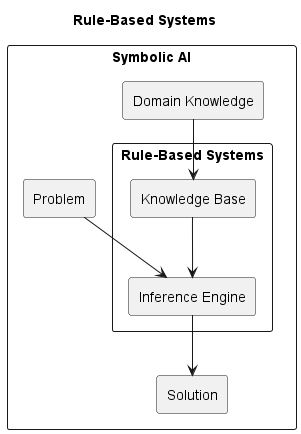Rule-Based Systems

@fig:rule-based-systems
During the initial stages of Artificial Intelligence (AI) development, Rule-Based Systems held a pivotal position within the realm of Symbolic AI. These systems were crafted to emulate human decision-making procedures through the utilization of a predetermined collection of rules. Rule- Based Systems found extensive application across diverse domains, encompassing expert systems, knowledge representation, and reasoning. This section will delve into the complexities associated with Rule-Based Systems, delving into their constituents, operational principles, and array of applications.
Rule-Based Systems are built upon a collection of rules that define the behavior and decision-making capabilities of an AI agent. Each rule consists of two parts: an antecedent (also known as the condition) and a consequent (also known as the action). The antecedent specifies the conditions that must be satisfied for the rule to be triggered, while the consequent defines the actions to be taken when the rule is fired.
Components of Rule-Based Systems
In a general sense, these are the main components of a rule-based system.
- Knowledge Base: The knowledge base acts as a storage area for the rules and facts that the system uses to make decisions. It contains a collection of rules, each representing a specific piece of knowledge or expertise.
- Inference Engine: The inference engine is responsible for applying the rules stored in the knowledge base to the provided input or problem. It compares the conditions mentioned in the rules with the available facts and activates the appropriate rules.
- Working Memory: The working memory holds the current condition of the system, including the facts and data relevant to the current problem. It is continuously updated as the system processes new information and employs rules.
Working Principles of Rule-Based Systems
Rule-Based Systems operate based on a cycle of rule matching and firing. The inference engine scans the knowledge base, searching for rules whose conditions match the current state of the working memory. When a rule is triggered, its consequent is executed, which may involve modifying the working memory or producing an output. This process continues until a termination condition is met or a solution is found.
Rule Acquisition
Rule acquisition involves the process of acquiring rules from human experts or through automated methods. This sub-topic explores techniques such as knowledge engineering, machine learning, and data mining for rule acquisition.
For instance, imagine a medical diagnosis system aimed at identifying potential illnesses based on a patient's symptoms. Rule acquisition for this system involves gathering the expertise of medical professionals or using automated techniques. One approach is knowledge engineering, where medical experts provide their insights and guidelines, which are then translated into rules for the system.
Let's say the system needs to identify the possibility of a common cold. The knowledge engineering process might involve consulting doctors who share their knowledge about common cold symptoms, such as sneezing, runny nose, and coughing. These symptoms, along with their potential significance, are transformed into rules within the knowledge base.
On the other hand, automated techniques such as machine learning and data mining can also aid in rule acquisition. The system could be trained on a large dataset of medical records, where symptoms are correlated with diagnosed illnesses. Using machine learning algorithms, the system learns patterns and relationships between symptoms and illnesses, which are then converted into rules by the inference engine.
In this way, rule acquisition plays a pivotal role in the effectiveness of the medical diagnosis system. It ensures that the knowledge and expertise of human professionals are harnessed, while also capitalizing on the power of automated methods to uncover hidden relationships in data.
Rule Evaluation and Conflict Resolution
Rule evaluation involves determining the applicability and relevance of rules in a given context. Conflict resolution deals with situations where multiple rules are triggered simultaneously, requiring a mechanism to resolve conflicts and determine the most appropriate action.
Consider the aforementioned example of a medical diagnosis system aimed at identifying potential illnesses based on a patient's symptoms. In this scenario, the system's knowledge base contains a set of rules that link various symptoms to potential illnesses. The inference engine processes the input provided by a user, which includes the symptoms they are experiencing.
For instance, if a user inputs symptoms like fever, sore throat, and body ache, the inference engine will search through the knowledge base to identify rules that match these symptoms. It may find rules like:
- Rule 1: IF fever AND sore throat AND body ache THEN possible diagnosis is flu.
- Rule 2: IF fever AND cough THEN possible diagnosis is cold.
In this case, both Rule 1 and Rule 2 are triggered by the input symptoms. This is where conflict resolution comes into play. The system needs to determine which diagnosis is the most relevant given the provided symptoms.
The conflict resolution mechanism in the inference engine evaluates the rules based on predefined priorities or conditions. For instance, the system might have a hierarchy where more severe conditions take precedence over milder ones. In our example, since flu is generally more serious than a cold, the system might prioritize Rule 1 over Rule 2.
Based on this conflict resolution process, the system would conclude that the most appropriate action is to suggest a possible diagnosis of flu to the user.
Applications of Rule-Based Systems
Rule-Based Systems are used in various fields, and these include:
- Expert Systems: Rule-Based Systems find extensive application in expert systems, aiming to capture and replicate the expertise and decision-making abilities of human specialists in specific domains like medicine, finance, and engineering. We will delve into the details of expert systems in the upcoming chapter.
- Diagnosis and Troubleshooting: Rule-Based Systems are employed in diagnostic systems to detect and resolve issues in intricate setups, like computer networks, industrial machinery, and automotive systems.
- Decision Support Systems: Rule-Based Systems are employed in decision support systems to aid in intricate decision-making processes by offering recommendations and suggestions based on predefined rules and available data.